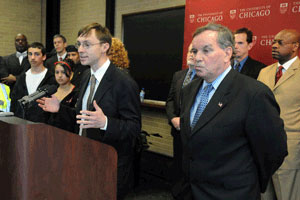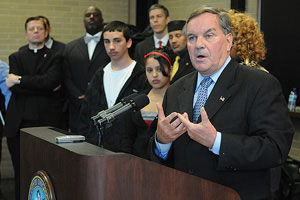Crime Lab will seek solutions to violence
By William HarmsNews Office
|
|
University scholars are collaborating with the City of Chicago and local philanthropists to help reduce gun violence among youths, the City announced at a Thursday, April 10 press conference.
Jens Ludwig, Professor of Social Service Administration, Law and Public Policy and a leading authority on crime and social policy, and Harold Pollack, Associate Professor in the School of Social Service Administration, faculty chair of the Center for Health Administration Studies and a prominent public health policy researcher, will lead a team of University and national scholars who will work with the City to develop interventions to reduce youth crime within a research framework that will provide the most scientifically rigorous evidence on effective solutions. The group will seek out foundations and donors in Chicago to finance these efforts, which are part of a larger initiative called the University of Chicago Crime Lab.
Ludwig and Crime Lab member Philip Cook, the ITT/Terry Sanford professor of public policy studies at Duke University, have estimated that the costs to society from gun violence may be on the order of $100 billion per year. The impacts extend far beyond those who are directly injured; not only are government resources drained, but safety concerns contribute to the flight of residents from cities to the suburbs. “Shooting victims aren’t the only victims,” Ludwig said.
“We envision broad strategies for youth violence prevention that would include efforts to promote positive youth development, as well as more traditional, criminal justice-oriented interventions designed to deter, restrain or rehabilitate youthful offenders,” Ludwig said. “We have two main goals for this project: One is to help steer youth toward productive activities like schooling and work, and away from behaviors like crime and gang involvement that put youth at elevated risk for violence victimization or offending; our second main goal is motivated by the fact that gun involvement makes youth violence substantially more dangerous. We want to reduce the likelihood that guns are involved in those violent events that do occur.”
|
|
The team is developing a range of candidate pilot projects, which will be reviewed with the City, to address these concerns. Program evaluation will be an important part of the University’s involvement so leaders can learn which approach works best, Ludwig said.
“The research evidence about what is actually effective to reduce youth gun violence is surprisingly limited,” Ludwig said. “If this collaborative project is successful, the result would be fewer shootings of Chicago youth as a direct result of our pilot interventions. The knowledge that we gain about what strategies are most effective also will represent an incredibly important contribution to government efforts to address this problem, both here in Chicago and nationwide.”
Pollack added, “Developing rigorous evidence about effective strategies will help determine what works and what is not the best use of scarce resources when it comes to reducing youth gun violence. These results may help our committed city partners to continue reducing youth gun violence throughout Chicago on an even broader scale.”
In partnership with the City, the University research team expects to examine promising new interventions based on previous research as well as interventions already under way.
The evaluation could help the city better allocate scarce resources across its youth violence prevention activities, Ludwig said. “Such evidence may also assist city efforts to sustain or expand successful interventions through foundation, state or federal resources.”
The committee will consider a variety of innovative new projects, which include examining how recently released, arrested or detained youths can complete their high school educations, providing youth with additional rewards and supports for good behavior, enhancing after-school program options for the highest-risk youth in Chicago, refining police patrol strategies and the effective use of police observation cameras, boosting community policing efforts, and dealing effectively with security and truancy.
Other Chicago scholars working on the project include Jeffrey Grogger, the Irving Harris Professor of Urban Policy in the Harris School of Public Policy Studies; Jonathan Guryan, Associate Professor of Economics in the Graduate School of Business; Steven Levitt, the Alvin Baum Professor in Economics and the College; John List, Professor in Economics and the College; Thomas Miles, Assistant Professor in the Law School; Charles Payne, the Frank P. Hixon Distinguished Service Professor in the School of Social Service Administration; and Diane Whitmore Schanzenbach, Assistant Professor in the Harris School of Public Policy Studies.
Other researchers are Jennifer Hill, assistant professor of international and public affairs at Columbia University; Brian Jacob, the Walter H. Annenberg professor of education policy at the University of Michigan; Tracey Meares, professor of law at Yale University; and Dennis Rosenbaum, criminal justice and psychology at the University of Illinois, Chicago.
![[Chronicle]](/images/sidebar_header_oct06.gif)

